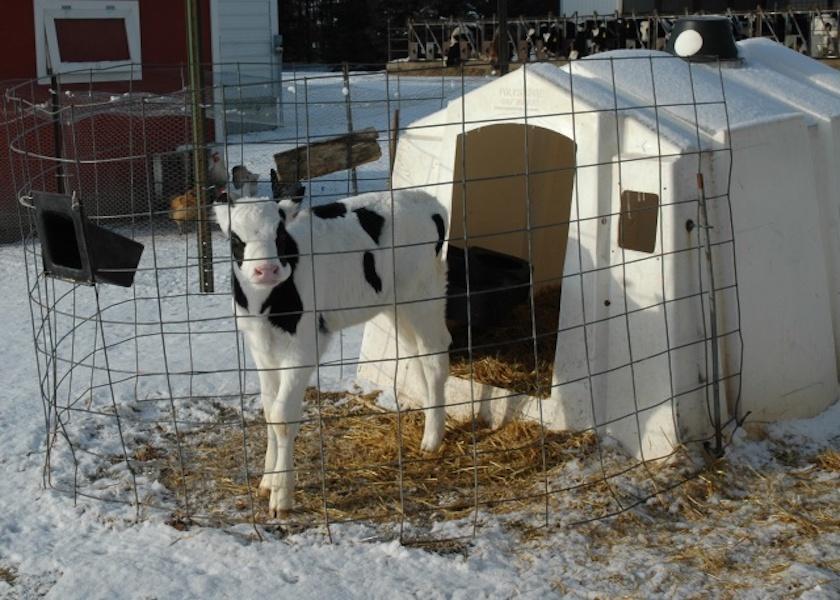Abomassal Bloat In Young Dairy Calves

This article was originally published in Dairy Herd Management in 2019.
Frigid winter weather ushers in a host of challenges for dairy operations, including keeping newborn calves alive and thriving.
Increasing liquid nutrients to young calves is widely recommended and implemented in cold climates. Because milk or milk replacer is the sole source of nutrition that can be digested by calves 3 weeks old and younger, the only way to deliver more nutrients to meet their increased, climate-induced energy needs is via the liquid ration.
In the first three weeks of life, calves are essentially monogastric animals, explains Australian dairy veterinarian Gemma Chuck.
“The abomasum is the only one of the four stomach compartments that is functional at this early stage,” says Chuck. “It has an acidic environment which helps in the formation of the milk clot before it passes to the small intestines for absorption of nutrients.”
Disruptions to the normal flow of milk through the abomasum can cause an overgrowth of the bacteria Clostridium perfringens type A. Colorado State University Veterinarian Dave Van Metre says C. perfringens type A is a part of the normal gut flora of calves, but its proliferation can produce the build-up of gas and large quantities of toxins. “This causes sudden distension of the abdomen and bloating on both sides of the belly,” notes Van Metre.
The condition usually presents as a fairly sudden attack. In addition to bloating, affected animals also may have diarrhea, mild depression, and signs of colic shown by calves kicking at their abdomen or lying flat out in attempt to relieve pain. Van Metre says death is the ultimate outcome for 50-60% of affected calves, and can occur within 6 to 48 hours if the bloat symptoms are not relieved. That’s why the frustrating scenario of a perfectly healthy calf at one feeding being found bloated and dead at the next can occur.
Several risk factors for abomassal bloat have been identified. They include:
Feeding large volumes of milk or milk replacer (> 3 quarts/liters) in a single feeding;
Feeding fortified milk or high-solids milk-replacer formulations;
Irregular feeding times;
Lack of water consumption;
Cool milk temperature; and
Inadequate colostrum intake.
Van Metre says the most urgent measure is to relieve the calf of bloat-inducing gases, using either a trocar or by passing a stomach tube. Severe cases also may call for an immediate dose of oral antibiotic suspended in mineral oil, followed by fluid therapy; subcutaneous antibiotic therapy; antitoxin; and/or flunixin for pain management.
But given the relatively poor prognosis of affected animals, prevention is a highly desirable alternative. The experts recommend focusing on:
Feeding delivery – Adding a third daily feeding, if possible, is preferable to increasing the volume of feedings. Feed on a consistent schedule, and once a dietary change has been made for the winter, don’t switch back and forth based on weather changes – stick with it.
Ration formulation and osmolality – Osmolality is a measure of the concentration of particles in a solution. Raising solids levels in milk replacer or whole-milk-based rations can push osmolality to dangerous levels, because it may slow the rate of abomassal emptying. Whole milk contains about 12.5% solids; avoid total solids greater than 14%. Many electrolyte products also have high osmolality.
Water – Although it’s challenging in winter, supplemental water consumption is absolutely essential in promoting the passage of nutrients through the calf’s digestive tract. Pay attention, also, to the sodium content of water. Do not feed or mix milk replacer with softened water, and have the farm’s water evaluated periodically for mineral content.
Mixing consistency – Work with your nutritionist or milk-replacer supplier to determine the correct formulation of your winter ration, then use a scale to weigh every batch of milk replacer. Even a 1% change in total solids can be troublesome for young calves.
Feeding temperature – Aim to deliver every feeding at 100-105˚F. In brutally cold weather, milk temperature can drop considerably during transport from the mixing station to the calves. Be aware, also, that milk replacer powder stored in very cold conditions can greatly affect the temperature of the reconstituted product.
Boosting liquid nutrients for very young calves in winter is in the best interest of the calf’s health and productivity, but it is not without risk. “It’s not simply, ‘adding a little more powder,’” cautions Chuck. “The correct mix rate will depend on each farm’s feeding system; frequency of feeding; milk-replacer brand and formulation; and the make-up of the base milk ration when fortifying whole milk.”







